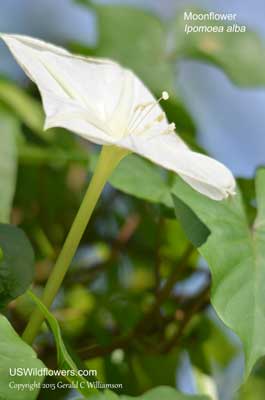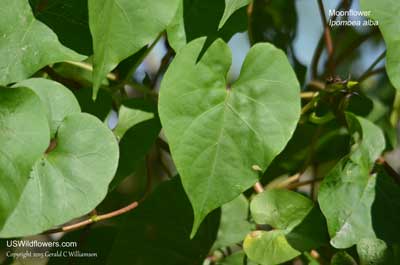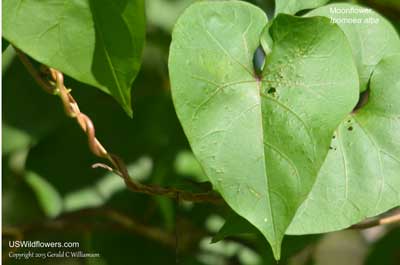Moonflower, Tropical White Morning Glory, Moon Vine, Evening Glory - Ipomoea alba
|
Ipomoea alba - Moonflower, Tropical White Morning Glory, Moon Vine, Evening Glory. Ipomoea is a large genus of well over 600 species worldwide, and over 60 in the United States. There is an Ipomoea species found in every state except for Idaho and Alaska (but those two states have members of the Convolvulaceae family present - the very similar genera Calystegia and Convolvulus.)
While the Morning Glory name is applied to most plants in the genus because their flowers, which can be especially glorious when large numbers are blooming, will close up or wither later in the day as the bright sun shines on them. However, that is not the case with Ipomoea alba - instead it opens later in the day and stays open on into the evening, yielding the common names Moonflower, Moon Vine, and Evening Glory.
Ipomoea alba is a tropical vine (a liana), being found mostly in Mexico, Central America and northern South America. Most authorities believe it to be native to Florida (and possibly Louisiana and Texas), but it is a non-native, naturalized plant in the few other states where it is found, probably because it is frequently used in gardens, as annuals in areas of the country not warm enough to allow it to survive as a perennial.
Synonym: Calonyction aculeatum
Found in:
AL, FL, HI, KS, LA, TX
Leave comments on Ipomoea alba at this link. | 
Distribution of Ipomoea alba in the United States and Canada:

Blue=Native; Grey=Introduced
Map from USDA Plants Database:
USDA, NRCS. 2017. The PLANTS Database (http://plants.usda.gov, 08 May 2025). National Plant Data Team, Greensboro, NC 27401-4901 USA.
Search Our Database: Enter any portion of the Scientific, Common Name, or both.
Do a general Google search of the entire site:
#ad
 Follow USWildflowers on Twitter
| | Site: Venice Rookery, Venice, Sarasota County, FL Date: 2017-December-12 | Photographer: Gerald C. Williamson
Nikon D7000
| | The flower of Ipomoea alba may be 5 or 6 inches across, and is white - sometimes with a hint of green, especially in the star that the flowers of many Ipomoea carry. The styles and stamens are exserted. There are reports that the flower may sometimes be pink, but I wonder if those are cultivars or perhaps instead Ipomoea turbinata, which does not have exserted stamens. | | 
| | Site: Venice Rookery, Venice, Sarasota County, FL Date: 2015-January-19 | Photographer: Gerald C Williamson
Nikon D7000 | | The shape of the flower is salverform - a long narrow corolla tube abruptly flaring to a more or less flat plane of 5 corolla lobes at the end. The tube may be up to 6 inches long, with the surface of the flower up to 6 inches across. | | Click on the photo for a larger image

| | Site: Venice Rookery, Venice, Sarasota County, FL Date: 2015-January-19 | Photographer: Gerald C Williamson
Nikon D7000 | | The leaves of Moonflower are heart shaped (as here) or 3-lobed, with a cordate base and acuminate tip. They are up to nearly 8 inches long and 6 inches wide, and are carried on a petiole up to 8 inches long. | | Click on the photo for a larger image

| | Site: Venice Rookery, Venice, Sarasota County, FL Date: 2015-January-19 | Photographer: Gerald C Williamson
Nikon D7000 | | Ipomoea alba is a twining vine growing to over 30 feet (some reports of up to 100 feet) in length; you can see it twining around the stem of another plant in the photo here. The stem and rest of the plant is usually glabrous, although it might occasionally be found with fine hairs. The stem may have some soft prickles which help support it on other plants, and has milky sap. | | Click on the photo for a larger image

|
References used for identification and information:
|
|
| |
| #ad
|
|






